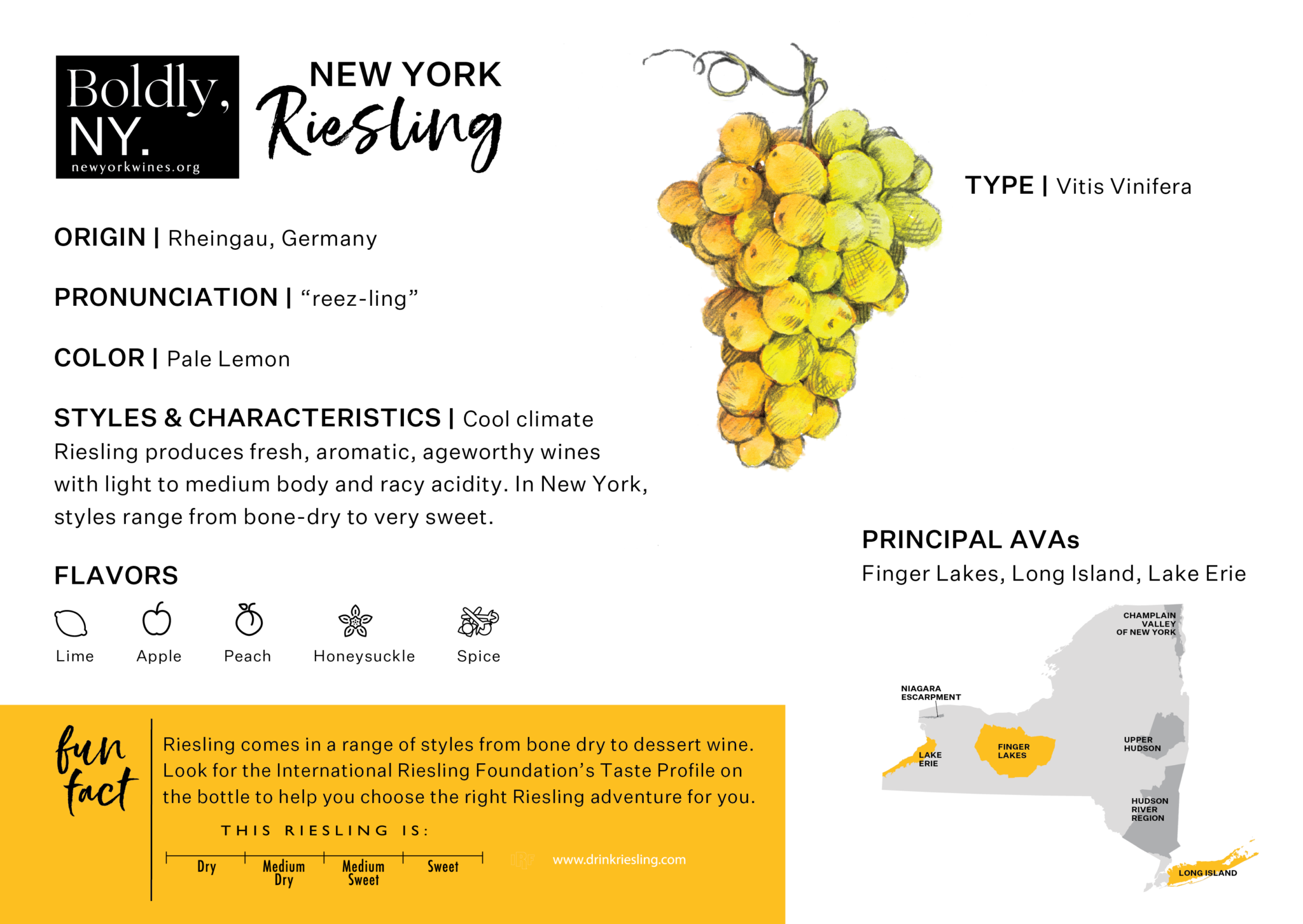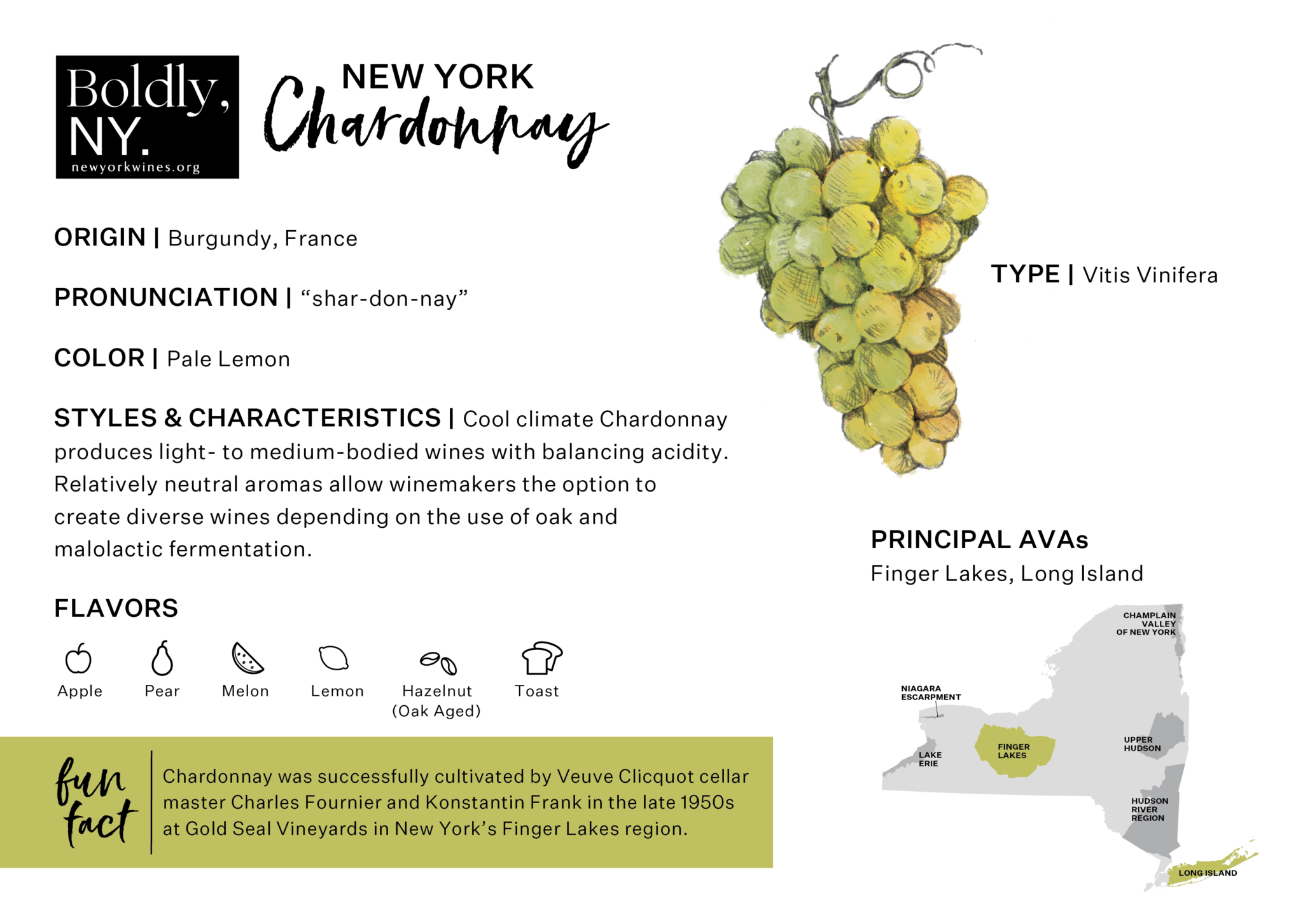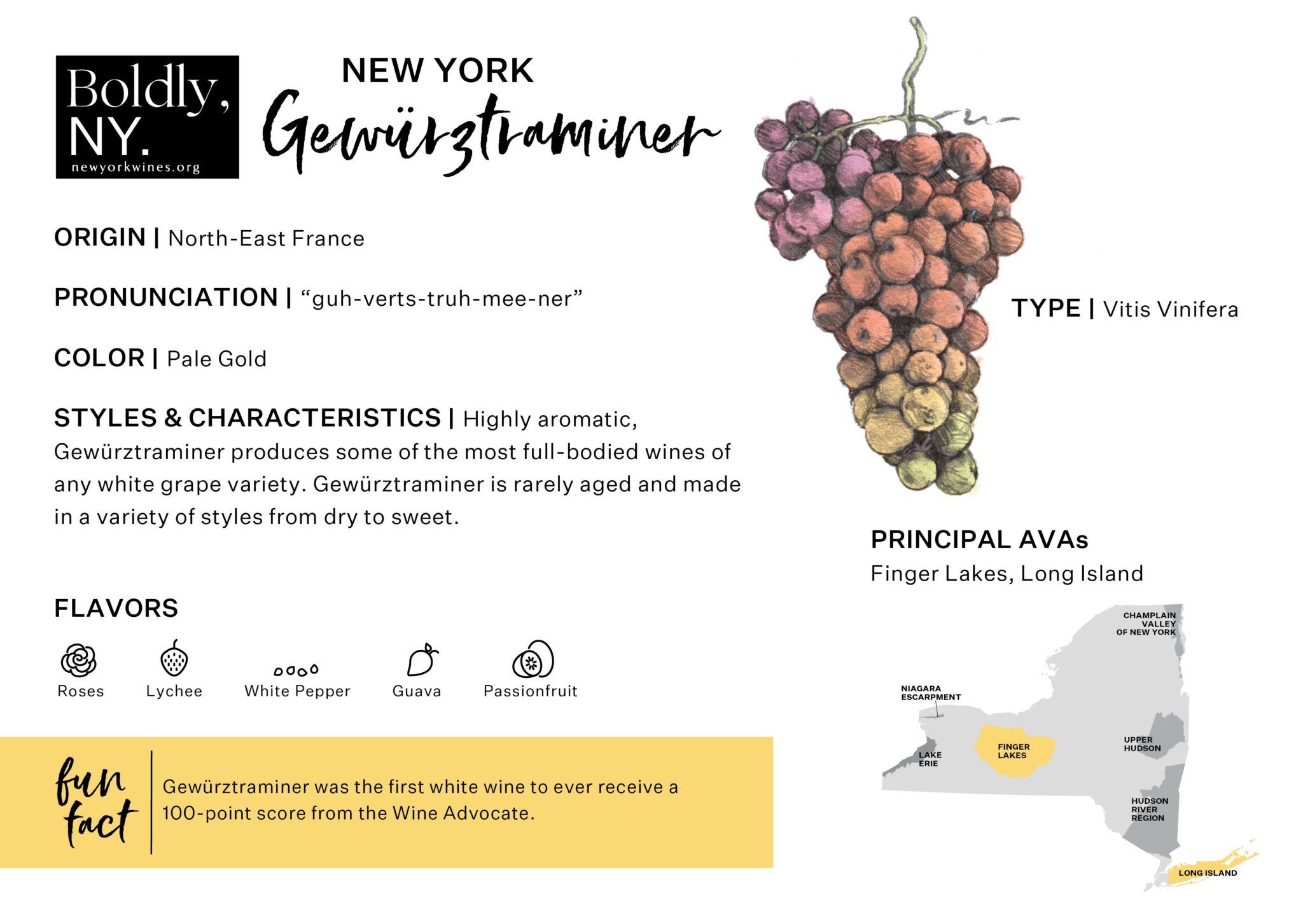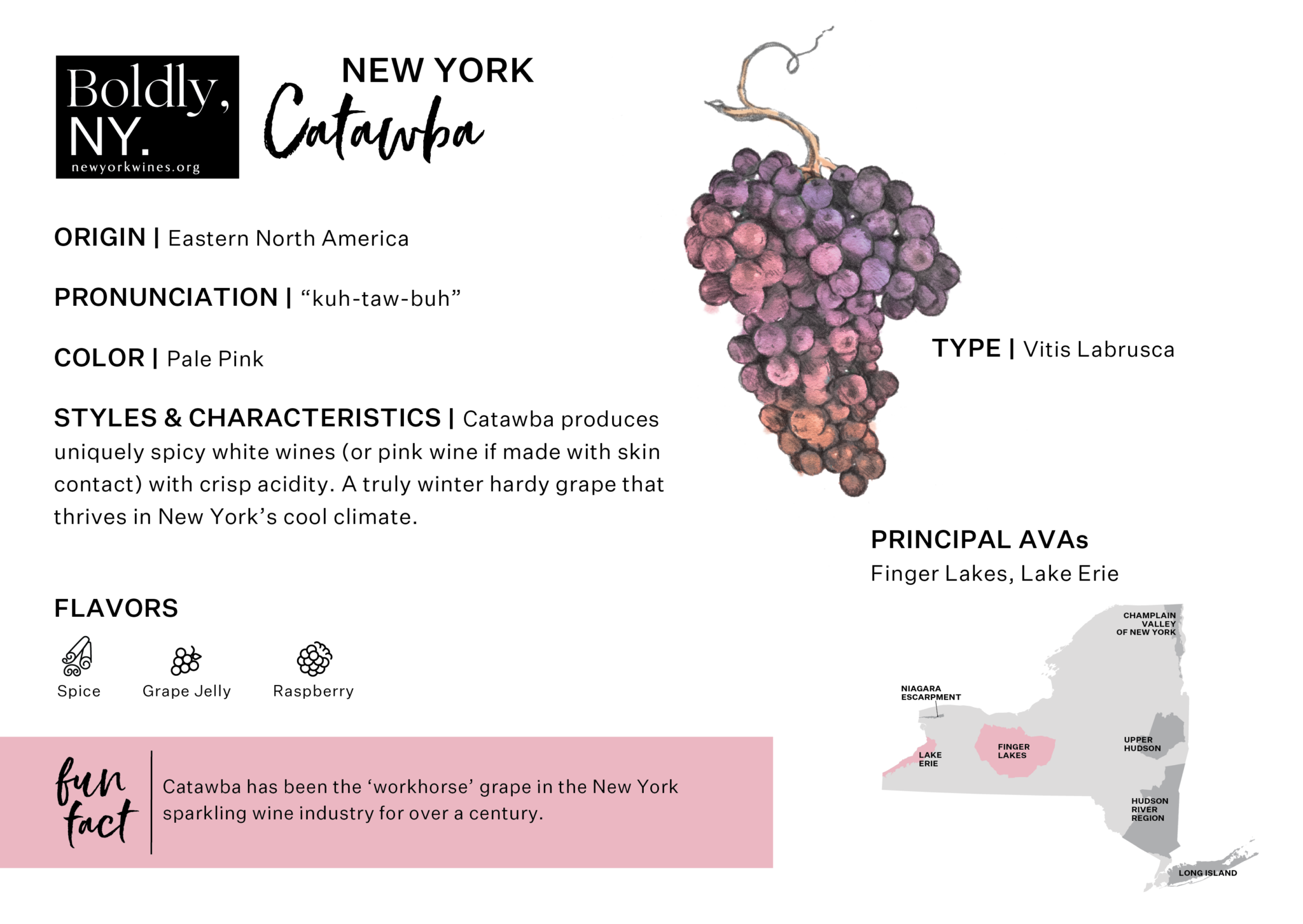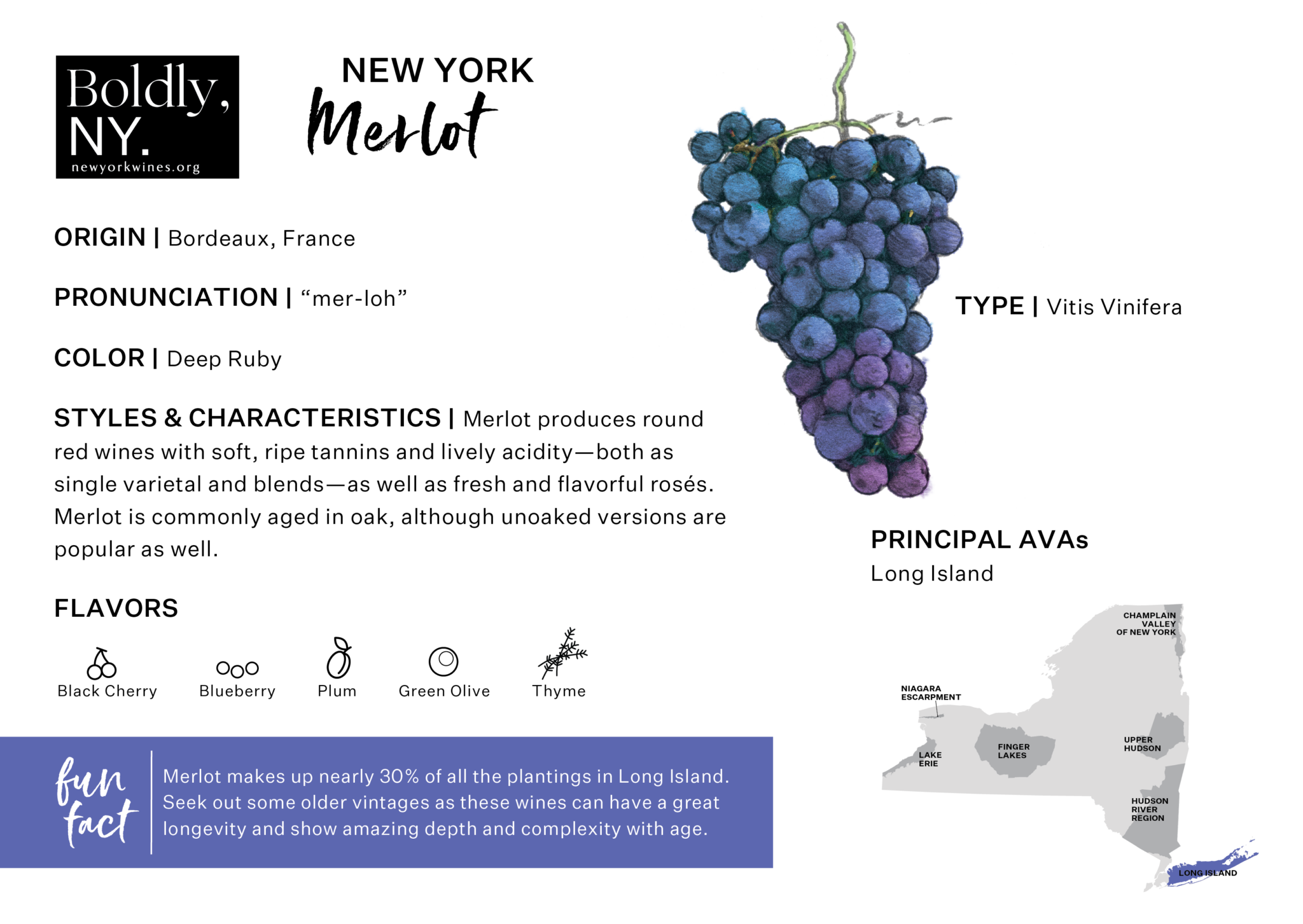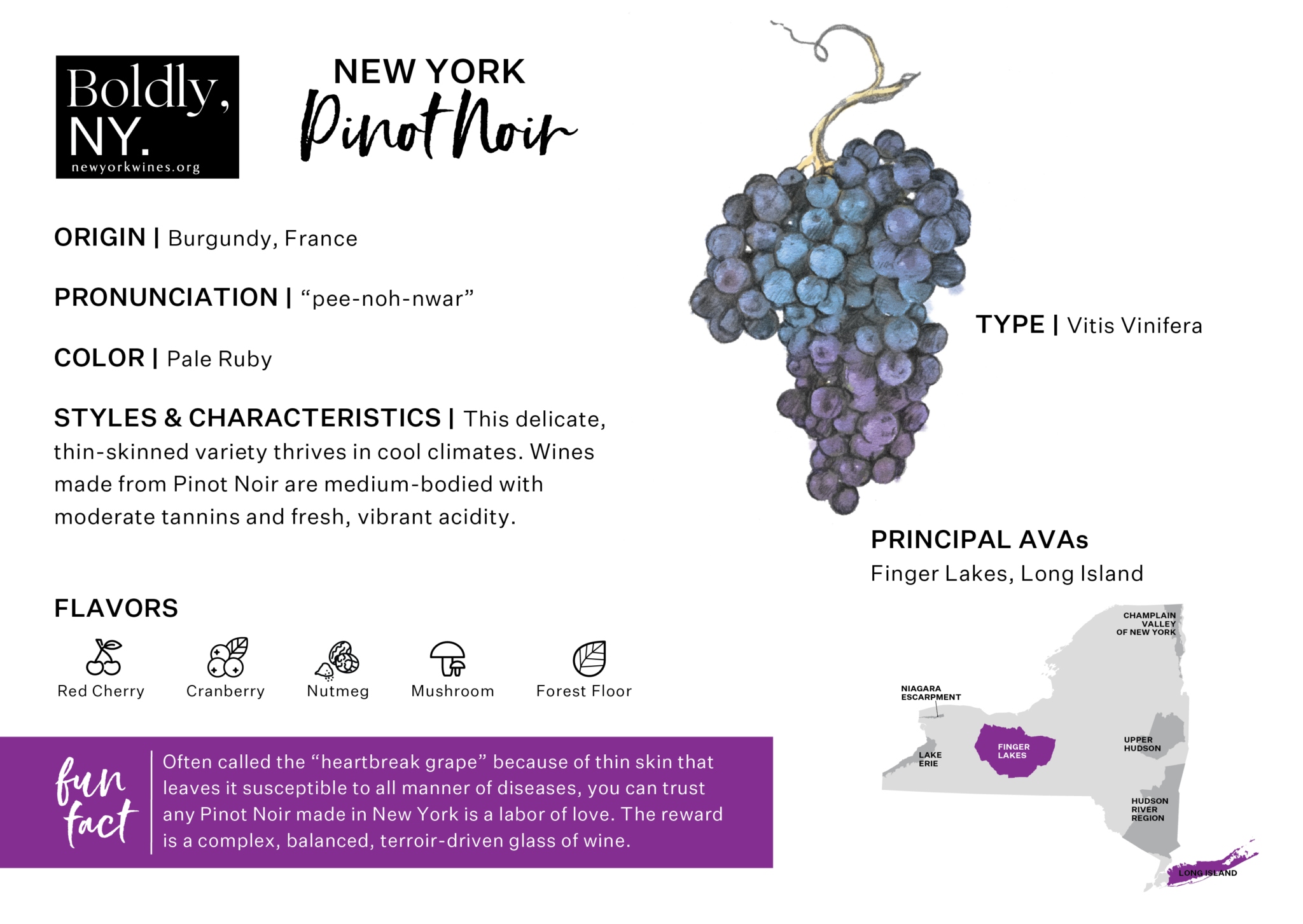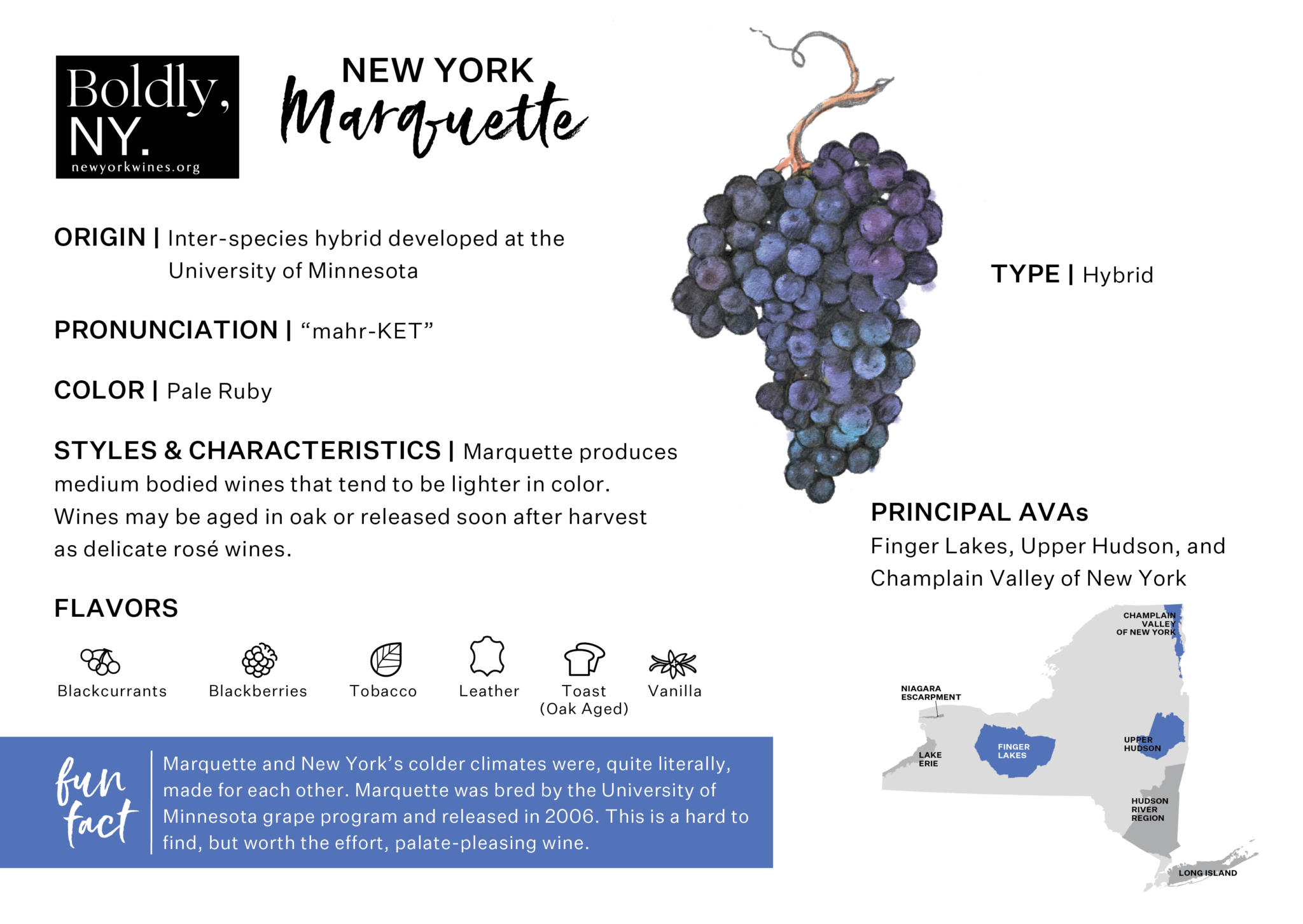New York State Grapes
new york's
We’ve got your favorite. And your next favorite. The variety in our vineyards and on our shelves will surprise you. No matter your taste, you’ll find something intriguing, satisfying or just downright delicious. You might already have a favorite New York wine, but you’ll find your next favorite here too.
White Grapes
Riesling
Origin: Rhine River Valley of Germany
Viticulture: Riesling is one of the most cold-hardy V. Vinifera grape varieties, making it well suited to the northern vineyards of New York State. Riesling clusters are compact with small berries and greenish-yellow skins. This variety’s ability to retain acidity through the late stages of ripening allow it to maintain a balance of flavor in concentrated, late harvest wines.
Principal AVAs: Finger Lakes, Long Island, Lake Erie
Acreage:
Finger Lakes: 849 acres
Long Island: 59 acres
Lake Erie: 42 acres
Hudson River Region: Less than 10 acres
Upper Hudson: Less than 10 acres
Niagara Escarpment: Less than 10 acres
Champlain Valley: Less than 10 Acres
Other Areas of the State: 63 acres
Total New York: 1,034 acres
Vinification: Cool to cold fermentation in stainless steel tanks helps to preserve the delicate flavors of this aromatic grape variety. Often aged in stainless steel, and occasionally aged in neutral oak, this variety is typically released the spring or summer after harvest.
Taste and Aroma: Cool climate Riesling produces fresh, aromatic, well-aged wines with light to medium-body and racy acidity. Rieslings have complex aromas with distinctive apple, stone fruit, floral, honey and spice character. New York Rieslings are finished with a variable range of residual sugar from bone-dry to very sweet. Excellent dessert wines are made from this grape when it is affected by the “noble rot” (botrytis cinerea) or allowed to dehydrate on the vine during late harvest.
Chardonnay
Origin: Burgundy region of France
Viticulture: Chardonnay is highly vigorous and cold-tolerant V. vinifera grape variety. Early flowering may increase the risk for springtime frost damage, so vines are sometimes pruned just prior to flowering to delay onset. Chardonnay clusters are small with petit, thin-skinned, amber colored berries. This highly adaptable variety can be grown in many different climates and vineyard soils.
Principal AVAs: Finger Lakes, Long Island
Acreage:
Finger Lakes: 351 acres
Long Island: 440 acres
Lake Erie: Less than 10 acres
Hudson River Region: Less than 10 acres
Upper Hudson: Less than 10 acres
Niagara Escarpment: Less than 10 acres
Champlain Valley: Less than 10 acres
Other Areas of the State: 29 acres
Total New York: 865 acres
Vinification: Chardonnay is made in a variety of styles that involve different winemaking techniques to boost complexity, including fermentation in stainless steel tanks, barrel fermented in new or neutral oak barrels, sur lee aging, malolactic fermentation, and months long aging in oak, concrete, or amphora vessels.
Taste and Aroma: Cool climate Chardonnay produces light to medium-bodied wines with balancing acidity. The rich bouquet and flavor of Chardonnay includes aromas of apple, melon, peach, pear, pineapple, lemon and citrus. Oak aged Chardonnays that complete malolactic fermentation may also show layers of butterscotch, butter, hazelnut, and toast flavors.
Gewürztraminer
Origin: Tyrol region of Italy
Viticulture: Gewürztraminer is one of the least cold-hardy of the V. vinifera grape varieties, although quality is highest when it is grown in cooler regions. The Gewürztraminer vine has moderate vigor, low to moderate yield, and compact clusters. Gewürztraminer berries are petit with a white pulp and thick pink skins that can attain high sugar levels during ripening.
Principal AVAs: Finger Lakes, Long Island
Acreage:
Finger Lakes: 108 acres
Long Island: 41 acres
Lake Erie: Less than 10 acres
Hudson River Region: Less than 10 acres
Upper Hudson: Less than 10 acres
Niagara Escarpment: Less than 10 acres
Champlain Valley: Less than 10 acres
Other Areas of the State: Less than 10 acres
Total New York: 155 acres
Vinification: Cool to cold fermentation in stainless steel tanks helps to preserve the delicate flavors of this aromatic grape variety. Gewürztraminer is rarely aged and made in a variety of styles from dry, to sweet, to sparkling. Gewürztraminer is occasionally blended, but not in significant proportion, as its distinctive aroma will overpower that of other grape varieties.
Taste and Aroma: Gewürztraminer produces some of the most full-bodied wines of any white grape variety with a pronounced spicy and tropical fruit aroma. Gewürztraminer is often described as smelling like lychee fruit or highly aromatic pink and white flowers. High sugars in Gewürztraminer can lead to high alcohol levels in dry versions of this distinctive white wine.
Catawba
Origin: Eastern North America
Viticulture: Catawba is winter hardy and vigorous, producing moderate yields of large reddish–pink grapes with V. labrusca “slip-skins” that slip off, leaving the pulp of the berry intact. This native North American variety ripens late and requires a long growing season.
Principal AVAs: Finger Lakes, Lake Erie
Acreage:
Finger Lakes: 864 acres
Long Island: Less than 10 acres
Lake Erie: 322 acres
Hudson River Region: Less than 10 acres
Upper Hudson: Less than 10 acres
Niagara Escarpment: 22 acres
Champlain Valley: Less than 10 acres
Other Areas of the State: Less than 10 acres
Total New York: 1,221 acres
Vinification: Catawba is often hot–pressed or given limited skin contact to yield pink juice. This variety was used in the 1970’s to create “pop” wines. Today it is used to produce wine coolers, sparkling wines, white and pink dessert wines, and grape juice.
Taste and Aroma: Catawba produces spicy white or pink wines, with crisp acidity, and a typical V. labrusca “foxy” aroma, which can also be described as the aroma of grape jelly.
Cayuga White
Origin: French-American hybrid developed at Cornell University
Viticulture: Cayuga White produces large, high yielding clusters. This early-ripening variety is winder hardy, disease resistant, and one of the most productive French-American hybrid varieties grown in the United States.
Principal AVAs: Finger Lakes
Acreage:
Finger Lakes: 338 acres
Long Island: Less than 10 acres
Lake Erie: Less than 10 acres
Hudson River Region: Less than 10 acres
Upper Hudson: Less than 10 acres
Niagara Escarpment: Less than 10 acres
Champlain Valley: Less than 10 acres
Other Areas of the State: Less than 10 acres
Total New York: 385 acres
Vinification: Cayuga White can be used to produce fresh, fruity wines with residual sugar, dry, oak-aged wines, or sparkling wines. This versatile grape is typically made into single varietal wines, although it can also be used for blending.
Taste and Aroma: Cayuga White produces white table wines with medium body and balancing acidity. The green apple and cotton candy-like aroma of this grape are brought out in wines that are finished with residual sugar.
Traminette
Origin: French-American hybrid developed at the University of Illinois
Viticulture: Traminette is a late budding, late ripening variety that shares some of the same flavor characteristics as the closely related Gewürztraminer grape. Vigorous but not overly fruitful, this hybrid grape variety is both cold-hardy and disease resistant.
Principal AVAs: Finger Lakes, Niagara Escarpment
Acreage:
Finger Lakes: 31 acres
Long Island: Less than 10 acres
Lake Erie: Less than 10 acres
Hudson River Region: Less than 10 acres
Upper Hudson: Less than 10 acres
Niagara Escarpment: 61 acres
Champlain Valley: Less than 10 acres
Other Areas of the State: Less than 10 acres
Total New York: 139 acres
Vinification: Traminette can be made dry or sweet, but it is usually finished with some residual sugar to balance its naturally high acidy.
Taste and Aroma: Traminette shares some of the distinct tropical fruit, floral and spice aromas of its Gewürztraminer parent.
Sauvignon Blanc
Origin: Bordeaux region of France
Viticulture: Sauvignon Blanc is a vigorous variety that grows well in many soil types across warm and cool regions. This green-skinned grape produces modest clusters with thin skins.
Principal AVAs: Long Island
Acreage:
Finger Lakes: 17 acres
Long Island: 82 acres
Lake Erie: Less than 10 acres
Hudson River Region: Less than 10 acres
Upper Hudson: Less than 10 acres
Niagara Escarpment: Less than 10 acres
Champlain Valley: Less than 10 acres
Other Areas of the State: Less than 10 acres
Total New York: 106 acres
Vinification: Cool to cold fermentation in stainless steel tanks helps to preserve the delicate flavors of this aromatic grape variety. Sauvignon Blanc is typically finished in stainless steel and sometimes aged in neutral French oak. Sauvignon can be used to make standout single varietal wines or blended with less aromatic white varieties to boost aroma and complexity.
Taste and Aroma: The aroma of Sauvignon Blanc can range from grassy to fruity, depending on climate and ripening conditions. Tropical fruit aromas include melon, papaya, and passionfruit.
Delaware
Origin: Eastern North America
Viticulture: This native North American variety is cold-hardy and vigorous, but susceptible to fungal diseases. Delaware produces moderate yields of red grapes in small, compact clusters that maintain high sugar and acidity at harvest.
Acreage:
Finger Lakes: 113 acres
Long Island: Less than 10 acres
Lake Erie: 55 acres
Hudson River Region: Less than 10 acres
Upper Hudson: Less than 10 acres
Niagara Escarpment: Less than 10 acres
Champlain Valley: Less than 10 acres
Other Areas of the State: Less than 10 acres
Total New York: 168 acres
Vinification: Delaware is used for producing dry, sweet, and ice wines, but it is prized for its use in sparkling wine.
Taste and Aroma: Unlike other V. labrusca grapes, Delaware does not have a distinctive “foxy” or grape jelly flavor. Delaware wines are light pink to white in color with a fruity, spicy aromas.
Red Grapes
Cabernet Franc
Origin: Bordeaux region of France
Viticulture: Cabernet Franc is moderately vigorous with small to medium-sized clusters. Cabernet Franc is thinner-skinned, earlier ripening, and lower in acid than the closely related Cabernet Sauvignon. Late and uneven color development are common in Cabernet Franc, leading to red wines that are lighter in color and tannin than other V. vinifera varieties.
Principal AVAs: Finger Lakes, Long Island
Acreage:
Finger Lakes: 236 acres
Long Island: 215 acres
Lake Erie: Less than 10 acres
Hudson River Region: Less than 10 acres
Upper Hudson: Less than 10 acres
Niagara Escarpment: Less than 10 acres
Champlain Valley: Less than 10 acres
Other Areas of the State: 20 acres
Total New York: 495 acres
Vinification: Cabernet Franc is used in both blending and single varietal red wines and rosé. The light pigmentation of this variety produces light to medium-bodied red wines. Neutral oak barrels are commonly used for aging Cabernet Franc, but fresher styles that have been aged in stainless steel, concrete, or amphora are also popular.
Taste and Aroma: Cabernet Franc wines tend to be light in both color and tannin. Depending on vineyard practices, this variety can be dominantly fruity or vegetal. Soft red fruit aromas such as strawberry, raspberry and bramble are typical of Cabernet Franc. Vegetal aromas of bell pepper or jalapeño are also characteristic of this variety.
Merlot
Origin: Bordeaux region of France
Viticulture: Merlot vines have moderate vigor with moderate to high yields. Early budding increases the potential for spring frost damage, yet early ripening avoids losses due to inclement autumn rains. Merlot is characterized by loose clusters of large red berries. Merlot berries have thinner skins, higher sugars, lower tannins, and softer acids than other red varieties, making for plush red wines.
Principal AVAs: Finger Lakes, Long Island
Acreage:
Finger Lakes: 87 acres
Long Island: 658 acres
Lake Erie: Less than 10 acres
Hudson River Region: Less than 10 acres
Upper Hudson: Less than 10 acres
Champlain Valley: Less than 10 acres
Other Areas of the State: Less than 10 acres
Total New York: 763 acres
Vinification: Merlot is used to make standout single varietal wines, red blends, and rosé. When blended, Merlot can improve the color, flavor, texture, and depth of more astringent red varieties, such as Cabernet Sauvignon. Merlot is most commonly aged in oak, although unoaked versions are popular as well. Merlot produces round wines with soft-tannins that often lend themselves to an earlier release than other oak aged reds.
Taste and Aroma: Merlot has a complex aroma of black fruit, earth and floral character. Merlot may show layers of cassis, black cherry, blackberry, blueberry and plum. Earthier notes include black and green olive, fennel, hummus, rhubarb, and tobacco. Floral and herbal notes associated with Merlot include eucalyptus, laurel, mint, sage and thyme.
Pinot Noir
Origin: Burgundy region of France
Viticulture: Pinot Noir is a cold-hardy, moderately vigorous, and low yielding vine. This delicate variety is susceptible to viruses, mildew and bunch rot due to thin skins and small, tightly packed clusters. Pinot has one of the earliest ripening and harvest dates compared to other V. vinifera varieties, making it well suited to grow in cool climates. Although Pinot Noir ripens early, it also ripens unevenly, making for a lighter style of red.
Principal AVAs: Finger Lakes, Long Island
Acreage:
Finger Lakes: 194 acres
Long Island: 87 acres
Lake Erie: Less than 10 acres
Hudson River Region: Less than 10 acres
Upper Hudson: Less than 10 acres
Niagara Escarpment: Less than 10 acres
Champlain Valley: Less than 10 acres
Other Areas of the State: Less than 10 acres
Total New York: 316 acres
Vinification: Pinot Noir has low pigmentation and tannin levels in the skin, making long fermentation on the skins and stems necessary to boost tannin levels during red winemaking. These same qualities make Pinot Noir ideal for making world class sparkling wines and rosé.
Taste and Aroma: Pinot Noir may have an intense aroma of black cherry and spice that suggests cinnamon, sassafras and mint. Earthy and vegetal flavors such as ripe tomato and mushroom are also present in Pinot Noir.
Marquette
Origin: Inter-species hybrid developed at the University of Minnesota
Viticulture: Marquette is vigorous, high yielding, disease resistant, and extremely cold-hardy, making it well adapted to grow in the northernmost parts of New York State.
Principal AVAs: Finger Lakes, Hudson River Region
Acreage:
Finger Lakes: Less than 40 acres
Long Island: Less than 10 acres
Lake Erie: Less than 10 acres
Hudson River Region: 40 acres
Upper Hudson: Less than 10 acres
Niagara Escarpment: Less than 10 acres
Champlain Valley: 20 acres
Other Areas of the State: Less than 10 acres
Total New York: 100 acres
Vinification: Marquette is used to produce jammy red wines that are aged in oak as well as delicate rosé wines that are released soon after harvest.
Taste and Aroma: Marquette produces medium bodied wines that tend to be lighter in color. Aromas of black fruit, such as cherries, blackcurrants, plums and blackberries, are characteristic of Marquette. Layers of earthy and spicy aromas such as tobacco, leather and black pepper are also typical. Oak aged Marquette may also present aromas of wood, toast and vanilla.
Lemberger / Blaufränkisch
Origin: Styria region of Slovenia
Viticulture: Blaufränkisch is an early budding and late ripening variety, making it well suited to warmer vineyards sites. This high yielding vine produces large leaves and large clusters with blackish blue, thick-skinned berries.
Principal AVAs: Finger Lakes
Acreage:
Total New York: Less than 10 acres
Vinification: Blaufränkisch is used to produce deep red wines that are typically aged in oak and occasionally aged in stainless steel.
Taste and Aroma: Blaufränkisch produces deeply colored, tannic, medium to full bodied red wines, with lively acidity. The aroma of Blaufränkisch includes red and black fruit notes of red current, cherry, and blackberry. Spicy aromas of cardamom and black pepper are also typical.
Saperavi
Origin: Country of Georgia
Viticulture: Saperavi is a moderately productive and cold-hardy V. Vinifera variety with large leaves and large, dark-blue, thin-skinned berries.
Principal AVAs: Finger Lakes
Acreage:
Total New York: Less than 10 acres
Vinification: Saperavi produces deep red wines that are highly suitable for aging. Saperavi can be made into standout single varietal wines or blended with lighter red verities to add color and depth.
Taste and Aroma: Saperavi has dark fruit flavors of cherry, plum, blackberry and blackcurrant. Spicy and earthy notes such as licorice, coffee, chocolate, leather and tobacco are also typical.
Frontenac
Origin: Interspecific hybrid developed at University of Minnesota
Viticulture: Frontenac is a vigorous, cold-hardy, disease resistant, hybrid that produces loose clusters of small, dark, highly acidic berries that develop high sugar levels during ripening.
Principal AVAs: Finger Lakes
Acreage:
Finger Lakes: 20 acres
Long Island: Less than 10 acres
Lake Erie: Less than 10 acres
Hudson River Region: Less than 10 acres
Upper Hudson: Less than 10 acres
Niagara Escarpment: Less than 10 acres
Champlain Valley: Less than 10 acres
Other Areas of the State: Less than 10 acres
Total New York: 40 acres
Vinification: Frontenac is used in the production of dry red wines, rosé, and fortified wines.
Taste and Aroma: Frontenac is characterized by red fruit flavors of cherry and red currant.
Concord
Origin: Eastern North America
Viticulture: Concord is cold-hardy, disease resistant, pest resistant, and productive. This native North American variety ripens in late mid-season, producing medium clusters of blue-black grapes.
Principal AVAs: Finger Lakes, Long Lake Erie
Acreage:
Finger Lakes: 2,220 acres
Long Island: Less than 10 acres
Lake Erie: 16,166 acres
Hudson River Region: 52 acres
Upper Hudson: Less than 10 acres
Niagara Escarpment: 366 acres
Champlain Valley: Less than 10 acres
Other Areas of the State: 18 acres
Total New York: 18,883 acres
Vinification: Concord is typically hot-pressed to extract color for sweet, red wines or pressed without skin contact to produce juice for sparkling wine production. Concord wines are always finished with more than one percent residual sugar, often as much as 10 percent for sweet dessert wines.
Taste and Aroma: Concord has a prominent “foxy” aroma, identical to the flavor of Concord grape jelly.
Cabernet Sauvignon
Origin: Southwestern France
Viticulture: Cabernet Sauvignon is vigorous and low yielding. It does particularly well in well-drained soils of low fertility. Heavy, fertile soils encourage too much foliage and depress yields. This variety is both late budding and late ripening, requiring a long growing season. Clusters are small, thick-skinned, and loose, making Cabernet Sauvignon very disease resistant. Cabernet Sauvignon berries are petit, dark, and seedy, contributing to characteristically high tannins.
Principal AVAs: Finger Lakes, Long Island
Acreage:
Finger Lakes: 104 acres
Long Island: 143 acres
Lake Erie: Less than 10 acres
Hudson River Region: Less than 10 acres
Upper Hudson: Less than 10 acres
Niagara Escarpment: Less than 10 acres
Other Areas of the State: Less than 10 acres
Total New York: 268 acres
Vinification: Cabernet Sauvignon produces robust, well-aged wines. This variety can be made into standout single varietal wines or blended in to Bordeaux-style blends. Typically, Cabernet Sauvignon wines are aged in oak for months or years to soften tannins before release.
Taste and Aroma: Cabernet Sauvignon has a complex aroma of black currant, bell pepper, eucalyptus, mint, black pepper, green olives, and tar. Oak aging can contribute toast, wood or vanilla flavors. Small grape size and high skin-to-pulp ratio in Cabernet Sauvignon leads to highly tannic, full-bodied red wines.
